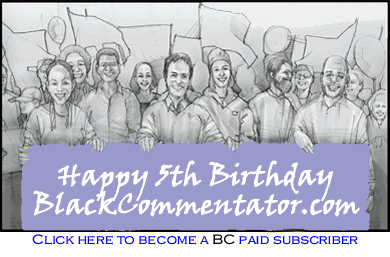
|
|||||||||||||||||||||
 |
|||||||||||||||||||||
 |
|
The future of urban politics and resulting social policies will be colored significantly by the political posture that Blacks, Latinos, Asians and other communities of color have towards each other. Collectively, these groups now have the capacity to represent a major political factor in determining the kinds of public policies that are adopted by city, state, and national governments in order to improve living conditions for all people in the nation. Working together, however, these communities can stop the ridiculous and rapid concentration of wealth that is depressing living conditions in this country and abroad. A few years ago political scientists Robert Klinker and Rogers Smith published a book identifying and explaining three major conditions that have been necessary for the realization of racial progress in U.S. history. In their book, The Unsteady March: The Rise and Decline of Racial Equality in America, they argue that progress toward racial equality, and I would add, thereby the expansion of economic democracy for all groups, has historically depended on the existence of three situations:
While I basically agree with this proposition, I add two other observations:
The consequences of the particular nature of conflict or consensus between these groups is a salient political matter all across the nation, but it is a key issue today in places like, New York City, Philadelphia, Atlanta, Washington D.C., Boston, New Haven, Hartford, Albany, Detroit, Dallas, San Francisco, Houston, Newark, Los Angeles, Miami Chicago, Memphis, and many other cities. Relationships between communities of color today represent a significant (albeit potential) political tool for re-igniting and revitalizing the call for expanding economic democracy in this nation, and in the international arena. In my opinion, it is this equation that can help in the adoption of progressive social welfare such as universal health care, full employment at living wages, massive investments in public schools, the building and rehabilitation of affordable and decent housing, guaranteeing worker rights, and the rights of women, including the right to abortion, and the reorganization of a criminal justice system that is consistent with international law, - these are policies and strategies that can weaken the structures that maintain racism, racial and ethnic divisions, and sexism. Collectively, these kinds of strategies serve to challenge the legitimization of greed inherent in major U.S. economic policies.
There are several developments that will continue to increase the importance of this issue in many cities. Demographic changes certainly support this claim. We know, for instance, that the White population is declining in relation to communities of color, and the latter are increasing in number and concentration. The essential fact of the matter is that the Latino and Black populations are growing rapidly in many cities – a fact far more important than the mainstream media’s simplistic fixation regarding Latinos bypassing Blacks as the largest "minority" group. And immigration is contributing significantly to what some have referred to as the "browning" and "blackening" of America. Accompanying growing overall racial and ethnic diversity is increasing ethnic diversity within these very same communities of color. Today, the Black community is composed of various ethnicities, as is the case with the Latino and Asian communities. Ethnic diversity means that terms like, "the Latino community" or "the Asian community" present erroneous monolithic impressions about these groups. It also means that terms like, "African-American", (rather than people of African-descent) as popular as it has become, may now be a demographic misnomer. There are many people from Haiti, Nigeria, Brazil, Columbia, Cuba, and Panama, for example, who will not call themselves African-American, but will say they are Black. This kind of ethnic diversity is changing the social agendas that traditionally have been associated with these groups. An issue like bilingual education, for example, traditionally a "Latino" issue in many places, is rapidly becoming a "Black" issue as a result of growing ethnic diversity within Black urban communities. Ethnic and racial diversity within what we have understood to be the Latino community is encouraging challenges to the notion that race, or racism, is absent among Latinos. As the Latino population continues to grow, social and economic differences between various Latino groups may challenge the notion of a Pan-Latino consciousness. Similarly, there are many groups within the Asian population that are different from each other in terms of economic and social conditions, language, and culture. Another situation that will keep prominent the issue of how communities of color relate to each other politically is the continuing presence of racism reflected in racial profiling, massive imprisonment of Black and Latino youth, employment and housing discrimination and hate crimes. These are problems that affect all of these groups in various ways. Despite unjust treatment of people from these particular groups on the part of government and the corporate sector, however, we cannot minimize the racial and ethnic conflict that has erupted between communities of color. Issues like bilingual education, legislative redistricting, government appointments, police-community relations, small business set-asides, access to affordable housing, and living conditions in the nation’s prisons have reflected intense conflict – even violence - between communities of color.
While it is a major mistake to minimize or ignore the degree and extent of conflict between communities of color, it is also a mistake to overlook the inspiring examples of political coalitions that have emerged between these groups in other periods, and the lessons they hold for the pursuit of social justice and the expansion of economic democracy in this nation today. Despite instances of political conflict, many of which have been overly sensationalized by the mainstream media, there are instances illustrating that important political victories have resulted from coalitions between communities of color. I believe the Civil Rights Movement provided some examples of this kind of coalition, but especially as it played out in many local places and neighborhoods across the nation. The "Community Control Movement" that unfolded in the Lower East Side neighborhood of New York City in the early 70s represented a political coalition of Latino, Black, and Asian parents – and a few White allies - seeking to exercise power in the area of public school policies. This coalition struggled against city government leaders, organized labor and the media, insisting that parents should have a place in helping to determine the policies and practices of public schooling. This coalition of parents and community activists forced a debate upon New York City that ultimately resulted in greater attention to the needs and well-being of Black, Latino, and Asian children, and thereby all children. The idea that the linguistic and cultural backgrounds of children is an important part of effective pedagogy in the public schools, and that even poor and working-class parents must be treated as partners in the public schooling processes became more accepted as a result of this political coalition. In spite of almost no mention of it by tons of scholarship on the Civil Rights Movement, there were a number of episodes pointing to the emergence of Asian – Black – Latino political coalitions aimed at pushing a social justice agenda in this country. In a previous Black Commentator essay, Jorge Mariscal reminds us that, During the Viet Nam War period, people of Mexican descent mounted a multi-faceted social movement that included:
Mariscal adds, "contact between Chicano and Black activists was often intense. In 1967, Tijerina began a close relationship with SNCC, the Black Panthers, and other militant groups. Chicanos participated in the New Politics Conferences and the Poor People's Campaign. One of Dr. King's planned stops after visiting striking sanitation workers in Memphis in April of 1968 was to have been Delano, California, and a meeting with Cesar Chavez. The meeting never happened; the specter of a Brown/Black coalition may have been one reason why."
Another earlier example of the impact of political coalitions between communities of color and its impact on social justice and economic democracy was the election of Harold Washington as mayor of Chicago in 1983. This was a significant event, and not only due to the fact that Harold Washington was Chicago's first Black mayor. Washington's election got many people, and not just Blacks, excited, and justifiably so. But really, how significant was this kind of ethnic trail-blazing breakthrough in terms of improving living conditions for poor people? This episode was far more important because of what Mayor Washington represented for the overall social and economic direction of one of the biggest cities in the United States. Mayor Washington believed that a city can be developed economically within a framework of just and equitable partnerships between downtown developers and neighborhoods. He believed that it was not necessary to sacrifice the well-being of any neighborhood in order to generate economic growth. And the eradicating of institutional racism was not an afterthought in his administration. It was primarily a coalition of Blacks and Latinos that allowed the mayor to devise policies and programs in order to pursue these kinds of goals. While support from the white liberal sector was also important, the critical base in the election and governing for the mayor was his support in both the Black and Latino communities. Mayor Washington would not have won the election, or reelection in 1987, or have been able to adopt a progressive vision for the city of Chicago without the majority of Blacks and Latinos and many of their leaders deciding that they must work together on behalf of a social and economic justice agenda for the entire city. There are many other examples of how political coalitions between communities of color emerged in a range of neighborhood struggles. One can turn to report by the Asian-American Foundation in New York City, Intergroup Cooperation in Cities: Africans, Asians, and Hispanic American Communities, or my own book, Blacks, Latinos, and Asians in Urban America: Status and Prospects for Activism, or other sources. These examples suggest at least six lessons for the building of progressive coalitions between Latino, Asian, and Black communities in the U.S. Firstly, we must acknowledge the historical and continuing role of race and the existence of an institutionally, socially, and culturally entrenched racial hierarchy in the nation. Racial hierarchy, where whiteness is treated as normal and superior to everything else, is maintained through even the "color-blind" policies and practices of institutions in this nation. John J. Betancur reminds us in his anthology, The Collaborative City, that, “the state is acting to dismiss racism, and the need for redress, while blaming Blacks and Latinos for their condition of underdevelopment...” He writes that the “obsessive denial of racism in the United States has become a new tool of racism.” This is a reality that cannot be ignored or invisibilized by activists in any community. The invisibilization of this social and economic reality only serves to weaken the possibility of powerful and progressive political coalitions. Secondly, grassroots activists and leadership in communities of color should understand the limitations of the politics of ethnic leapfrogging. The purpose of collaboration is not to advance the careers of so-called ethnic trailblazers, but rather to develop policy agendas that can be supported across these communities, and that benefit all communities.
Thirdly, cultural and historical information should be exchanged with each other. Cultural and youth organizations have a major role to play regarding this lesson. Obviously we cannot rely on universities or public schools to provide a history of the struggles and contributions of people of color in this country. Yet, understanding such histories of struggles actually encourages the building of coalitions among groups who have been exploited in various ways by American capitalism, because they gain insight about how similar the struggles were in terms of intent. Youth in all of these communities must be made aware of their own community’s history of struggle, and the purposes of such. This will emerge as an important bridge for future political cooperation, and including political cooperation in the prisons of America. Fourthly, grassroots activists and leaders representing communities of color have a responsibility to challenge public policies, and practices that are adverse to the well-being of any one group, even though such policies may not impact directly on one’s own group. "Injustice anywhere, is a threat to justice everywhere", to quip Dr. Martin Luther King, Jr. Ultimately, the moral purpose of these kinds of coalitions is not to guarantee that one group"s concerns will be responded to, or accommodated by interests with wealth and power, but rather that we will all be able to live in a more just, rational, and economically-efficient society that benefits all people. Fifthly, if political coalitions on behalf of progressive social and economic agendas are going to be viable, then we have to change the contemporary civic dialogue about the possibilities regarding the expansion of economic democracy. In many places the dominant civic dialogue is about "standards", or "accountability", or "self-responsibility", or "parental responsibility". This civic dialogue must be challenged because it intentionally hides race and class, but it also separates resolutions about the manifestations of racial and class inequality from the practices and policies of economic, educational, and political institutions that support interests who hold enormous wealth. The dominant civic dialogue is framed by the presumption that racial and class inequalities have nothing to do with the particular policies and practices of institutions, or that the role of wealth and power is irrelevant to racial inequality. We see an example of this situation when civic dialogue focuses on the lack of morals, or self-responsibility on the part of Black or Latino youth without any mention whatsoever of how the management and distribution of wealth denies young people fundamental tools and opportunities for attaining social and economic benefits. We see it when legislation like welfare reform is passed, focusing on the presumed and pathological behavior of poor women, while overlooking a history and contemporary practices that keep poor and working-class women in economic subjugation. And we see it when we debate how those poor people in the neighborhoods might be motivated to help themselves, but we don’t mention how corporate giants representing the most dependent sector in our society are allowed to pursue policies that contribute to deteriorating living conditions in these same neighborhoods.
And, finally, coalitions between communities of color have to be based on the pursuit of power rather than access to power. Power is not based on strategies molded by the suggestion that people have to choose the "lesser of two evils" when it comes to deciding whom to support politically. That is, we must support the Democratic Party blindly and loyally lest the Republicans get back into power. Power is not based on the idea that we need to "get a piece of the pie", without questioning the role of wealth, and the concentration of wealth, in maintaining poverty and poor living conditions for the working-class in this society. Unfortunately, both of these ideas have led too many of our leaders to adopt the role of apologists for the Democrats or advocates for the Republicans and the corporate interests that support both parties, rather than focusing on the building of a progressive policy agenda for social change. And, thus the political focus among them is simply, "how to stop the Republicans", or "how do we get the Democrats not to take us for granted", or who can promise us more access into their agenda. These kinds of questions do not speak to power and the unjustifiable and immoral concentration of wealth in U.S. society. The advancement of social movement linked to economic democracy has been muffled by the fact that some leaders representing communities of color simply have become cheerleaders for dominant interests representing wealth, and the two national parties. Coalitions between Blacks, Latinos, and Asian activists, and White allies, can only work effectively, and have an impact on empowering a progressive social and economic agenda, if they are guided by the building of short, and long-range political power that is not necessarily based on who is in office. If we return to some of the lessons of earlier coalitions, then we realize that the essential framework for effective coalitions has to be one of social movement, and mobilization across communities on the basis of expanding economic democracy. It has to be a framework not directed by ethnic leapfrogging and that is so traditional in U.S. politics. The organizing framework has to be based on social justice and the expansion of economic democracy in the form of universal access to free and quality health care, living wages for all workers, massive investments in public schools throughout the nation, guaranteed employment and jobs in the rebuilding of the country’s physical infrastructure, and the de-militarization of U.S. society.
It is this kind of framework that will trigger a new movement for social change that is led, in part, by communities of color. How ironic life is: the very groups who have been exploited, who have been treated as outcasts and intruders, who have been enslaved, and who have suffered as a result of racism and discrimination, and institutional mistreatment on the part of government, now have the collective, albeit still potential, power to again move the nation onto a path of social justice and economic democracy. BC Editorial Board member James Jennings, PhD is a professor of urban and environmental policy and planning at Tufts University. Click here to contact Dr. Jennings. |
|
| Home | |
| April
5, 2007 Issue 224 |
||||||||||||||
|
||||||||||||||
| Printer Friendly Version in resizeable plain text format | ||||||||||||||
 |
||||||||||||||
|
||||||||||||||
 |
||||||||||||||
 |
||||||||||||||
 |
||||||||||||||
| |
||||||||||||||
| |
||||||||||||||



































